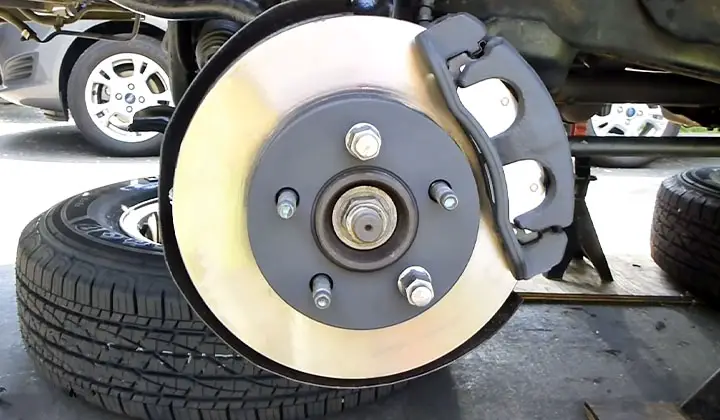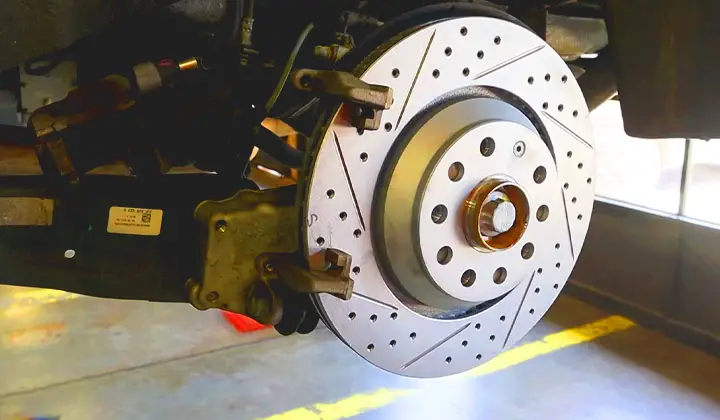Rotors come in both front and rear-wheel drive configurations, but they operate differently. The front rotor is geared to the engine and helps it turn faster than the rear rotor.
When you need to change a tire on your car or truck, you use the front-wheel-drive because it’s easier to reach under the vehicle.
Rear-wheel drive vehicles are more common in trucks and SUVs because they offer better traction when off-roading or driving over snow or ice.
A four-wheel-drive system allows all of the wheels on a vehicle to work together for better traction. To prevent skidding, most vehicles have either electronic stability control (ESC) or anti-lock braking systems (ABS).
Contents
Are Front and Rear Rotors the Same
The front and rear rotors on your car should be of the same size and type. If one rotor is bigger or smaller than the other, it can cause problems with your car’s braking system.
You may need to have your rotors replaced if they become warped or damaged in any way. Replacing both rotors at once will save you time and money in the long run.
The front and rear rotors are often the same sizes, but they may not be exactly the same. This can cause your car to skid or hesitate when you brake. To check if your rotors are the right size, you will need to measure them with a caliper.
Similar Looking
The front and rear rotors are very similar in shape and size, but there are a few key differences that you should be aware of.
The front rotor has five holes while the rear rotor has four. Furthermore, the front rotor is made from metal while the rear rotor is made from plastic.
Same Number of Holes
All four rotors have the same number of holes – this helps to reduce noise and improve performance.
Same Shape
The shape of both front and rear rotors is identical – they are shaped like discs with circular edges.
Purpose Of Front Rotors
The front and rear rotors help to avoid skidding while driving. They’re also responsible for stopping the car in a straight line. If one of these rotors is worn or damaged, it can cause problems on the road.

Get Grabbed by the Brake Caliper
When you apply the brakes, your truck’s front and rear rotors must stop simultaneously. If one rotor stops before the other, it can get grabbed by the brake caliper.
This can cause your truck to slow down quickly and may even require you to use all of your braking power just to stop.
Slow the Truck
The smaller size of a rear rotor means that it is not as powerful as a front rotor when it comes to stopping a vehicle quickly. As a result, your truck will need more time than usual to come to a complete stop on an emergency stop or while driving in traffic.
Purpose Of Rear Rotors
Do Less of the Braking
By having two braking surfaces instead of one, a Rear Rotor is able to do less work during hard braking situations in order to conserve energy and prolong tire life.

Contains Two Braking Surfaces
A Rear Rotor also has two braking surfaces which allow for better overall performance when braked hard compared to single-surface rotors found on most trucks today.
Reduces Fuel Consumption and Emissions
By slowing down or preventing your car from rolling away, rotor systems reduce fuel consumption and emissions by helping keep your engine running in its optimal condition
How To Choose the Right Type of Rotor
When you get a new car, one of the most important things to do is to choose the right type of rotor.
There are several types available on the market today and it can be hard to know which one is right for your needs.
Rotor size
The first thing you need to know is what size of rotor do you need for your car. There are three main types of rotors: standard, large, and XL.
Standard rotors are generally smaller than large or XL rotors, while larger rotors offer more stopping power. It’s important to choose the right rotor size for your bike based on its weight, speed, and terrain.
Type of braking system
If you have a hydraulic brake system, then you need a rotor with an embedded fluid sealer that helps evacuate any water and dirt from the brake pad when it becomes wet during operation (this prevents sudden ground contact noise).
If you have a cable-actuated brake system, then a less expensive synthetic-blend rotor may work just fine without an embedded fluid sealer since there is no need to remove water or dirt from the pad during operation (although some riders do install one just in case).
Brake surface material
Rotor surfaces come in either metal or ceramic materials; both offer their own benefits and drawbacks depending on how they perform under various conditions (metal has better performance at high temperatures but can rust over time while ceramic offers resistance to oxidation and corrosion but doesn’t handle heat as well).
Ceramic also tends to vibrate less than metal brakes making them quieter under heavy use but can become noisy after extended periods of use if not properly lubricated.
Weight difference between front and rear brakes
Most bikes come equipped with front calipers only; if your bike has rear disc brakes, then you’ll need to purchase additional hardware including mounting brackets, pads, and discs separately before installing them on your bike’s frame.
Rear caliper weights tend to be heavier than those found on front calipers due to their greater capacity so choosing a heavier rear rotor will usually result in a stronger braking force applied evenly across all four wheels even when using inferior quality pads compared to those used on most front setups.
ABS works similarly to how our brakes work; by using sensors inside of the wheel hubs, it can detect an impending stop and apply pressure before your tires actually touch the ground.
The different types of rotors also affect how quickly your car will accelerate from a stop: For example, a larger diameter rotor will slow down less quickly than a small one would so that you can get up to speed more easily
FAQs
Are Front and Back Rotors Interchangeable?
No. Front and rear rotors are not interchangeable. One rotor is designed for a specific use and it cannot be used for the other.
Why Are Front and Rear Rotors Different?
The front and rear rotors are two different types of rotors that are used in helicopters. They differ in terms of the way they generate lift.
Are Front Rotors Bigger Than Rear?
This is a common misconception that many people have about helicopters. The front rotor is actually smaller than the rear one and the rotors are symmetrical in size.
Should You Replace Rotors in Pairs?
It is a common practice for automotive mechanics to replace rotors in pairs. However, there are some signs that this practice may not be necessary.
How Many Brake Rotors Does a Car Have?
A car has four brake rotors.
Should I Replace All 4 Rotors?
It depends on a variety of factors, including the age and make of your car, the cost of replacement, and even the driving habits you have.
Conclusion
If you’re looking for a safe and efficient ride, it’s important to make sure your rotors are the same size on both the front and rear of your vehicle.
By doing this, you can eliminate any chances of having to replace either rotor in the future- saving you time and money.
Always have your brakes inspected by a professional if they’ve been replaced recently or if there is any sign that they may not be working properly.
You should also regularly inspect all other parts of your car – including tires, lights, wiper blades, etc – to ensure they are in good condition as well. Driving without proper safety precautions could lead to serious consequences.
So be sure to take steps now to avoid them. For more information about choosing the right rotor for your car or truck please visit our website or contact one of our experts today.
